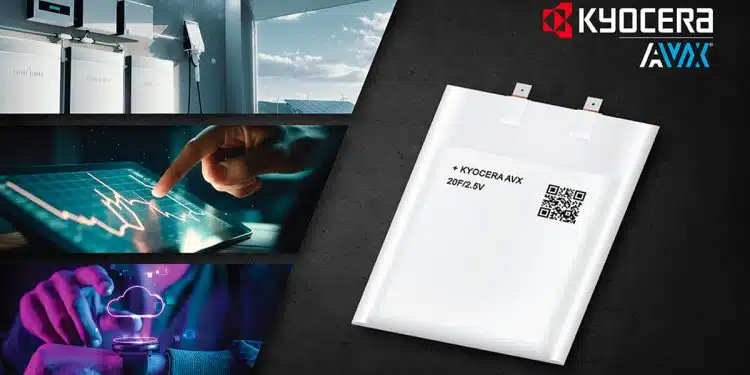The new Gen II PrizmaCap supercapacitors deliver higher capacitance, voltage, and energy density than Gen I PrizmaCaps and exhibit higher reliability across a wider range of operating temperatures. Ideal applications extend across the medical, consumer, commercial, and industrial electronics industries.
KYOCERA AVX, a leading global manufacturer of advanced electronic components engineered to accelerate technological innovation and build a better future, expanded its PrizmaCap line of rugged, high-capacitance, and high-reliability supercapacitors with the release of two new Gen II series.
The new Gen II PrizmaCap supercapacitors, also known as prismatic electrochemical double-layer capacitors (EDLCs), deliver higher capacitance, voltage, and energy density than Gen I PrizmaCaps and exhibit higher reliability across a wider range of operating temperatures. Gen II PrizmaCap supercapacitors also feature a rugged, lightweight, and low-profile SMT package equipped with fixed position terminals that extend from the same end and compatible with hand soldering.
The new PrizmaCap SCP 2.5V Series supercapacitors deliver the lowest profile and widest operating temperature range of any KYOCERA AVX supercapacitor. They are rated for operating temperatures extending from -40°C to +65°C at 2.5V and -40°C to +85°C derated to 2.0V. The new PrizmaCap SCP 2.5V HT Series supercapacitors deliver the lowest profile and highest operating temperature of any KYOCERA AVX supercapacitor. They are rated for operating temperatures extending from -25°C to +65°C at 2.5V and -25°C to +105°C derated to 2.0V.
Both series measure 50mm x 46mm (L x W) with a maximum thickness of 2.3 for 6F parts, 2.8mm for 13F parts, and 3.4mm for 20F parts. They are rated for 2.5V, exhibit S-level tolerance (+30%/-10%), and are backed by high-reliability testing for lifecycle, high-temperature load life, temperature and humidity characteristics, and vibration resistance.
Gen II PrizmaCap supercapacitors are designed for use in applications that require pulse power handling, energy storage, power hold-up, and battery assist and can be used by themselves or in conjunction with primary or secondary batteries to provide extended backup time, longer battery life, and instantaneous power pulses as needed. Ideal applications include medical devices, tablets, e-readers, IoT and IIoT devices, VR wearables, handheld electronics, Bluetooth keyboards, and power peripherals.
They are lead-free compatible and compliant with IEC 62391-2-2006, UL 810A, RoHS, and REACH requirements and are shipped in tray packaging. Lead-time for standard parts is currently 18 weeks and will vary for custom designs.































